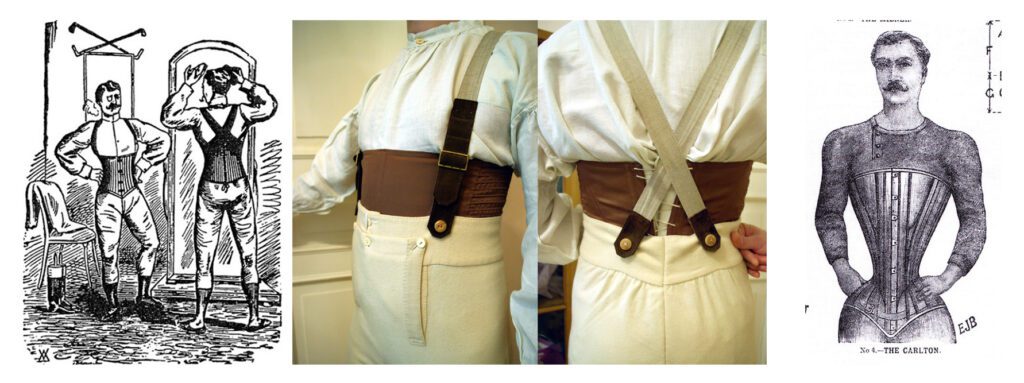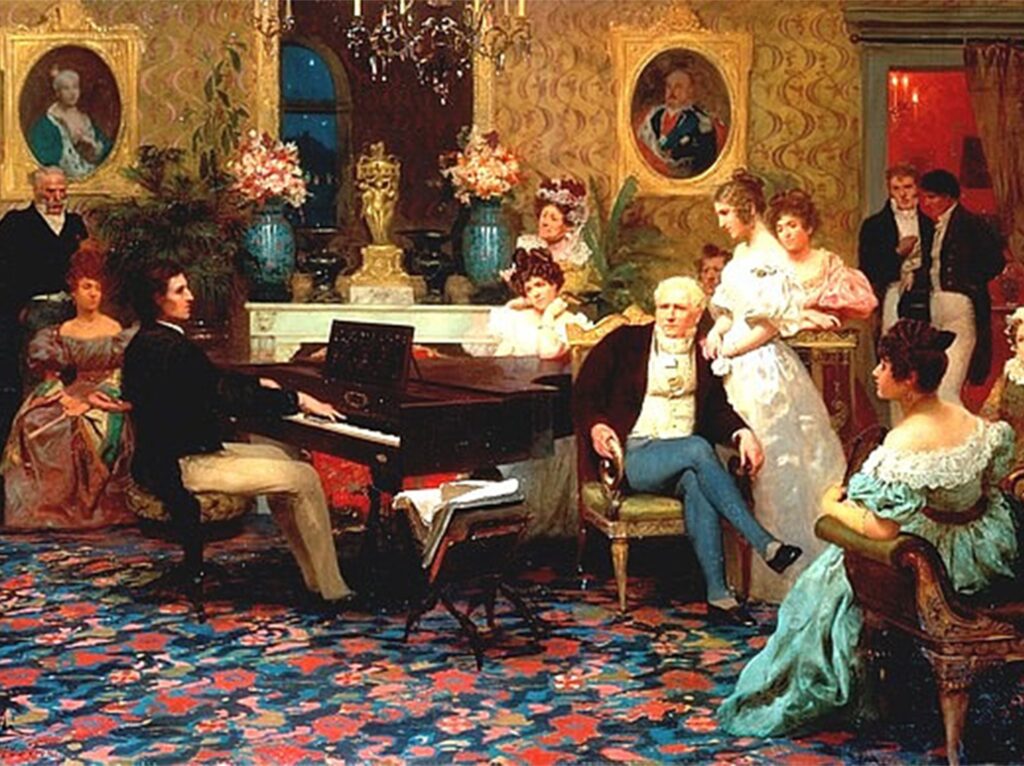The Romantic Period (1820-1850) derived its name from the Romantic Arts movement, in which art, literature, and music was focused on the emotions and feelings rather than the rationality of Neoclassicism.
A wide sort of breeches, pantaloons, and trousers, and hat styles were fashionable during the Romantic era. Knee breeches, or culottes, had been used as an emblem of the French ancient régime and were seldom worn outside mandated court styles.
The textile industry was booming during the Romantic period numerous forms of textiles might be produced. The fashionable textiles were the lightweight ones: silk taffetas, cotton voiles, cotton calicoes, cotton batiste, wool challis.

Clothing for Men
Men within the Romantic era often wore linen undershirts, for similar reasons to women. Linen was warm, comfortable, and easily cleaned. Men’s linen shirts of the time were typically bleached white. Sometimes the shirts were made from muslin, but that was generally reserved for higher classes. Men started to wear tight-fitting trousers called pantaloons, with coats that been nipped at the waist. It was customary for the trousers, waistcoat, and coat to various colors.

Undergarment
Stays were kind of corset or bodice which were worn by men. Some men wore Stays to create the required smooth silhouette.

Clothing for Women
Silhouette and Two-piece dresses
The Silhouette for ladies during this time is characterized by a waistline moving down from under the bust to many inches above the natural waist, fuller skirts with increased decoration at rock bottom, and a large kind of sleeve. Skirts gained width at the bottom with ruffles, floral embellishments, Italian quilting, and padding, but lost the puffed hemline by 1835.

Outdoor Garments
Mantlet, Shawl Mantlet, and Pelerine Mantlet
At first, A Mantlet was a shorter coat with a cloak or wrap-like qualities often emanating from interestingly devised sleeves or the illusion of sleeves. But during the Romantic period, it was an ornamental scarf that crossed over the chest and tied behind, usually made of fur or lace. Mantlets could be in various types like shawl mantlet and pelerine mantlet.

Burnous
A Burnous was a long cloak of coarse woolen fabric with a hood, usually white in color, worn by both men and women during the Romantic period. The color of the Burnous could be white, beige, or dark brown. The burnous was worn during important events and by people with high positions.

Paletot
Paletot was a French top-coat. It was a semi-fitted coat with peaked lapels and a flat back that worn without any belt. Its double-breasted 6×2 button arrangement had top buttons placed wider and they were not buttoned. A paletot was usually made from flannel or tweed in charcoal or navy blue.

Pardessus
Pardessus could be either quite loose or fitted at the waist, depending on the wearer and the fashions of the season. The pardessus forms might be various, whether in velvet, satin de chine, Casimir, or drape cachemire.

Accessories Garments of Dress
Chemisette
A chemisette was an article of women’s clothing worn to fill in the front and neckline of any garment. Chemisettes gave the looks of a blouse or shirt worn under the outer garment without adding bulk at the waist or upper arm. Chemisettes of linen or cotton were often worn with day dresses within the mid-19th century and will be decorated with tucks, embroidery, or lace.
Pelerine
A pelerine was a small cape that covers the shoulders. In the world of fashion, it was most popular during the mid to late 19th century in Europe and the Americas. These could be made of various materials, including muslin and silk. They might be adorned with embroidery, beadwork, ruffles, or even featherwork. Crocheted pelerines, Muslin pelerines, and Fichu pelerines were also common.

Undergarment
Bodices/Corsets developed a V shape and women began to wear tighter corsets for a trim look, although the lower classes wore high waists until 1830. The Petticoats became more decorative with lace or embroidery. And the Drawers became puffier.

Clothing For Children
Basically, the children wore the dress like their parents. Girls wore simple dresses and boys wore dresses like their father.

Makeover of Romantic Period
The women of the Romantic era liked to be natural makeup. But they took care of their skin so much. They used moisturizer and light face powder on their face.

Accessories
For Men
The Stock and cravat were very popular neckwear during the Romantic era which was worn with any cloth that tied around men’s necks for decorative purposes. As such, it is the forefather of the tie, the bow tie, scarves, and even ascots.
For Women
For Women Bonnets, gloves, and parasols were the staples of a woman’s accessory wardrobe within the Romantic period, but sashes, ribbons, and bows were at the peak of their popularity. Also wrapping themselves with shawls, mantles, and stoles was very fashionable for women with day and evening wears. They used chatelaine for their daily purpose and fashion. A chatelaine might be a decorative belt hook or clasp worn at the waist with a series of chains suspended from it. Each chain was mounted with useful household ancillaries such as keys, scissors, vinaigrette, thimbles, watches, and any other household seals.

Footwear of Romantic Period
Romantic Period boots were mostly made with the sharp square toe area of caramel leather, the upper area of ribbed silk, a small corded rosette to the front, edged with narrow silk tape, side lacing with original laces with brass ends, hand-embroidered eyelet holes, the tongue of same silk lined with puce silk and with vandyked edges, lined in white cotton, with blue edged tape support for eyelet holes, leather soles, left and right. One small hole below the lacing on the right-hand boot. The tongues had slightly frayed edges. Some wore to the soles.
#fashion_history_of_romantic_period, #fashion_history_of_19th_century
Image source: [google, wikipedia, blogs, etc.]


